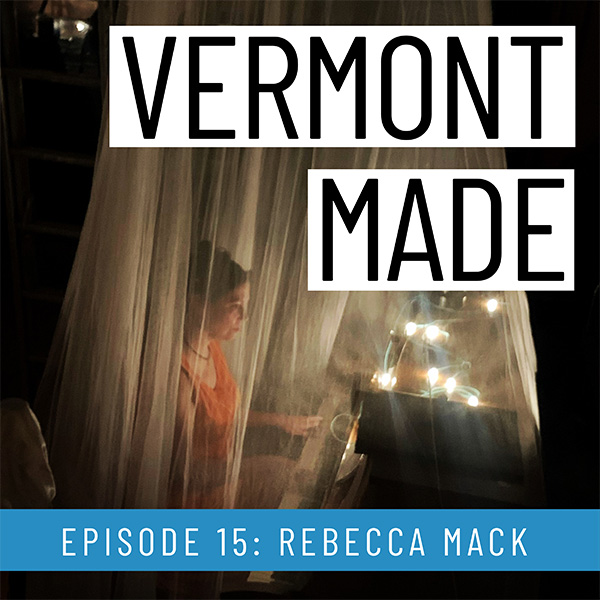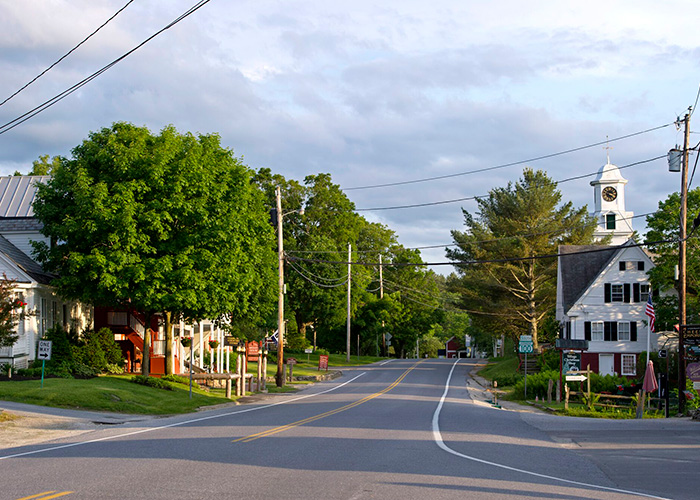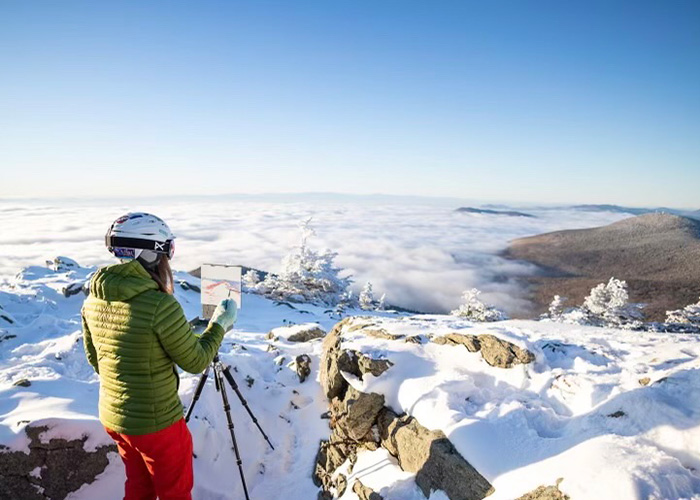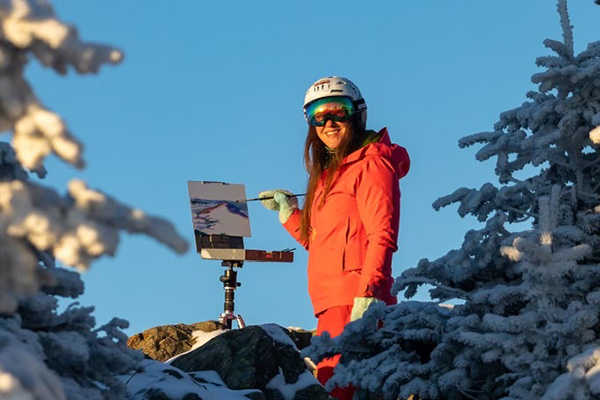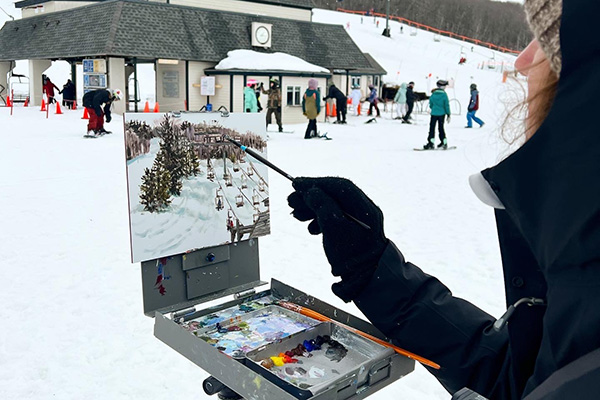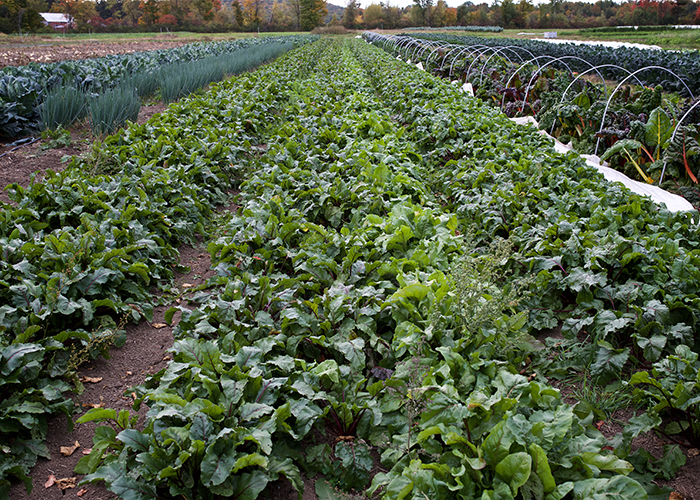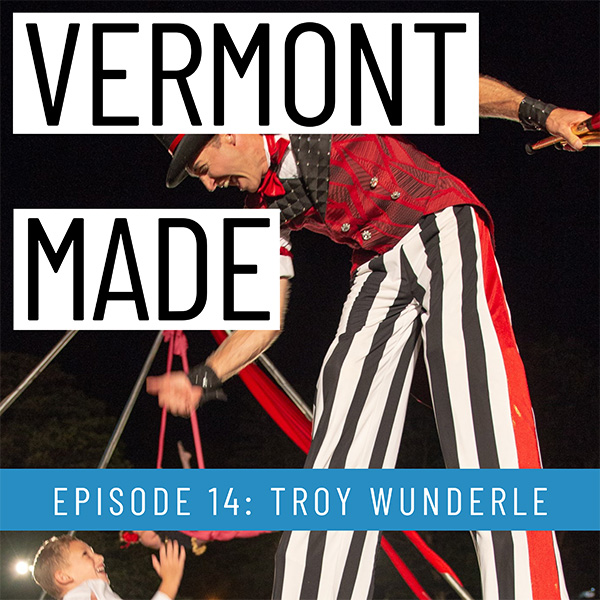
by Shelley Pembroke | Jan 5, 2024 | Arts, Podcast
In episode 15 of Vermont Made, musician and teaching artist Rebecca Mack discusses her new song cycle, “Body,” inspired by her experiences with long Covid disability, climate change, and the shared impermanence of the human body and the Earth body.
Listen to Grooving with Impermanence with Musician Rebecca Mack
Sharing the fruits of local talent from the Green Mountain State. In each episode of Vermont Made, one artist, craftsperson, designer, specialty food producer, or other Vermont creative shares the story behind one thing they’ve made. Produced by the Vermont Arts Council and hosted by Desmond Peeples.
In 2023 and 2024, Vermont Made is sponsored by the Vermont Department of Tourism and Marketing.

by Shelley Pembroke | Dec 21, 2023 | Communities, Podcast
Healthy communities require safe streets and sidewalks; inclusive gathering places and green spaces for everyone to enjoy; and easy access to medical services and fresh food. If you live in a rural town in America, these things can be hard to come by. Join Suzanne Kelley and Richard Amore in Small Towns, Healthy Places, the podcast that explores the intersection between health equity and community design in the State of Vermont. They’ll interview state partners, local leaders, and community members about creating vibrant places that support health and wellness. If you’re passionate about public health, improving the built environment, and placemaking, this podcast is for you.
About this episode
In the spring of 2022, the US Surgeon General released an advisory calling attention to the public health crisis of loneliness, isolation, and lack of connection in our country. Social isolation is an issue nationally and people living in small and rural towns are certainly not immune. Rural places connected only by highways and dirt roads make it harder to get around if you don’t drive, and cold winters make it more difficult to enjoy outdoor activities and gathering places. Racism and socio-economic barriers can also make people feel isolated in the communities where they live. To make small towns into healthier places, we need to reduce isolation and improve feelings of social connectedness.
We’ll hear from Arwen Turner, Executive Director of Come Alive Outside, Sung-Hee Chung, activist and founder of Powered Magazine, and Kelly Stoddard Poor, Director of Outreach at AARP. Each of our guests today brings a different approach to enriching our social fabric and social connectedness. A sense of belonging can improve people’s lives by almost every measure, from physical health to mental well-being.
Listen to this podcast on Spotify or wherever you get your podcasts.
Visit healthycommunitiesvt.com for more information and to get the full episode transcript.

by Shelley Pembroke | Nov 29, 2023 | Arts, Lifestyle, Outdoor Recreation
Hi there. My name is Carrie Pill. This winter I challenged myself to skiing and plein air painting all of Vermont’s 20 alpine ski areas and now that the season is winding down, it’s time for a recap!
The Person
I am a professional artist and passionate skier with a love for discovery, community, and sharing. I wanted to ski all of Vermont’s ski areas and tie it into my work, as a result, ‘A Painted Tour’ was born.

The Challenge
I set myself a goal for the 2022/2023 winter: to ski and plein air paint all 20 Vermont alpine ski areas. Some amazing partners helped me achieve my goal. Thank you Ski Vermont, Stio and the Vermont Department of Tourism.
A typical day on ‘A Painted Tour’
- Wake up. Breakfast. Pack up car. Go!
- Arrive. Bundle up. Walk, take lift or ski to painting spot.
- Paint for a couple hours.
- Break. Warm up in lodge. Refuel.
- Transition. Put painting materials in car. Change gear if needed.
- Ski. Sometimes with a buddy. Cover as much ground as possible. Take notes, pictures and video.
- Apres. Sometimes with a friend. Sometimes another painting session.
- Dinner. Often times back at the room or home. Sometimes at a local spot.
- Bring paints and paintings inside. Wash brushes. Hot shower. Hang up ski gear. Plug in electronics. Set up for the next day.
- Share. When time and energy allowed, I would create a post or video from the day.
- Sleep. Repeat!
Watch a short video of a typical day: Quechee Club
Getting There
Many of these visits began with a scenic drive. What is it about the open road that ignites introspection? I indulged, decompressing while taking in Vermont’s most iconic roads: Route 100 N, Route 7 South, 116…
Painting Warm
Upon arrival I would throw on my warmest gear, preparing to paint first and ski second. I discovered from previous plein air days that painting before skiing was the driest, warmest and smartest approach. You can imagine my struggle of fighting the urge to grab first chair. Once that brush was moving though, I could easily let that sense of urgency go.
“How did you decide where to paint?”
Before arrival, I might have a hunch about where I’d like to paint that day. On more than one occasion, a lift hold, poor visibility or precipitation would force a pivot. This included painting inside a base lodge, inside the car or at the base of the mountain.

“Doesn’t the paint freeze?”
Oil paint is a rugged friend. You can count on oils to come out and move around in the cold with you. Would they eventually freeze if left cold enough, long enough? Absolutely. My paint box typically moved from a heated vehicle or room to my backpack to the easel. This ensured that the paints started warm. Most of these plein air sessions did not exceed four hours. The coldest painting session I did was -7 degrees Fahrenheit. These mighty paints were up for the task.
When the easel went up…
I was pleasantly surprised by the curiosity and enthusiasm that I was met with. Painting is typically such a solitary activity.
People asked questions, took pictures and watched the process. Some folks stopped by after each lap to see the progress, others shared fondest memories and favorite facts about the ski area.
Thank you if you stopped by. You gassed me up and made me feel at home.
“What was the favorite place you visited?”
This question is tricky as I have my home favorite: Pico Mountain. There were ski areas that surprised me; naturally, those ones stick out in memory. Who doesn’t love it when an experience delivers above and beyond? I keep coming back to the fun I had at the hills – that is, the itty bitty ski areas. These were the unexpected incredible ski experiences. Rope tows, cheap tickets, handmade signs, fire pits, jeans, $1 hot cocoas, T-bars, classic rock blaring, and packs of kids cutting loose. It was wholesome, nostalgic, community-supported, and felt like home to me. I treasure my memories at Lyndon Outing Club, Cochran’s Ski Area, and Northeast Slopes.
Of course I happy danced…
…to powder days at Stowe, to waterpark après at Jay and rockstar Bolton tree runs. The variety of ski and snowboard experiences and terrain that Vermont offers is vast and vibrant.

Your Mountain Communities
Even the largest of Vermont’s ski areas had a sense of community. Skiing and painting the Vermont 20 was an opportunity to get out of my comfort zone. I was often that awkward girl traveling, skiing, and painting alone. I am so grateful for the locals who were willing to meet up with me. This deepened my appreciation and understanding of our ski areas. Thanks friends! Watch short video: Tour friends
Skiing and Painting VT Tour Stats
- 65 season ski days to date (as of 4/24)
- 34 paintings (and counting): including 3 studio, 1 interior and 3 nocturne paintings
An Unforgettable Season
Now here we are, brushes are clean, most of the paintings have found homes and my warmest gear is now stowed away. It flew by. What surprised me was the energy. I thought it would be a struggle to motivate at times. Each visit instead fed me so much so that I couldn’t wait for the next one. Painting and skiing at all of Vermont’s ski areas was an absolute joy and a privilege, but it was not without its challenges. Yours truly found herself humbled on some of the most technical trails and tough conditions, locked out of an Airbnb at night in a Nor’easter, and emotionally wrecked after losing a pet.
Life happens. ‘A Painted Tour’ pushed me to figure it out when I was thrown a curve ball. When it got tough, I had something amazing to lean on: my dream project.
This is a season I will never forget. Thanks for being awesome Vermont.
Thanks for reading. I hope to see you out there! -Carrie

by Shelley Pembroke | Nov 20, 2023 | Communities, Podcast
Healthy communities require safe streets and sidewalks; inclusive gathering places and green spaces for everyone to enjoy; and easy access to medical services and fresh food. If you live in a rural town in America, these things can be hard to come by. Join Suzanne Kelley and Richard Amore in Small Towns, Healthy Places, the podcast that explores the intersection between health equity and community design in the State of Vermont. They’ll interview state partners, local leaders, and community members about creating vibrant places that support health and wellness. If you’re passionate about public health, improving the built environment, and placemaking, this podcast is for you.
About this episode
Having access to nutritious food is a key ingredient in health equity. But it can also be a key ingredient in building healthy communities where Vermonters feel connected to one another and their neighborhood. Food can bring people together to share their culture, their heritage, and give them a sense of belonging.
Today we are focusing on gardening and produce. We are highlighting organizations and people that are helping to remove barriers to getting local fruits and veggies. Along the way, we’ll discuss the added social benefits of gardening together and sharing food.
We’ll hear from Michelle Gates, the Executive Director of the Vermont Garden Network, and Nour El-Naboulsi, the Co-Director of The People’s Farmstand. We’ll also chat with Cindy Delano and Jethro Hayman, leaders in their respective community gardens.
Listen to this podcast on Spotify or wherever you get your podcasts.
Visit healthycommunitiesvt.com for more information and to get the full episode transcript.

by Shelley Pembroke | Oct 16, 2023 | Arts, Video
In episode 14 of Vermont Made, acclaimed circus educator Troy Wunderle discusses Vermont’s vibrant circus community, the essence of clowning, and receiving the 2022 Excellence in Circus Education Award from the American Circus Educators Association.
Listen to Clowning from Within with Circus Educator Troy Wunderle
Sharing the fruits of local talent from the Green Mountain State. In each episode of Vermont Made, one artist, craftsperson, designer, specialty food producer, or other Vermont creative shares the story behind one thing they’ve made. Produced by the Vermont Arts Council and hosted by Desmond Peeples.
In 2023 and 2024, Vermont Made is sponsored by the Vermont Department of Tourism and Marketing.
